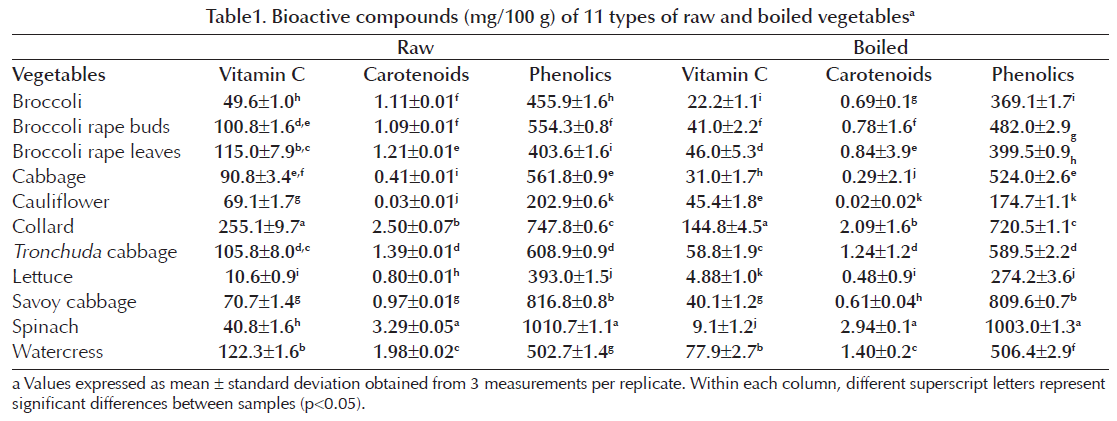Health benefits of green vegetables in the Mediterranean diet
The Mediterranean diet was recognized by UNESCO as an Intangible Cultural Heritage, being characterized by a nutritional model that has remained constant over time and includes a large variety of vegetables. The consumption of green vegetables has, undoubtedly, a positive effect in health promotion, reducing the risk of cardiovascular diseases, cancer, cataract and macular degeneration, obesity and Type 2 diabetes, among others1.
Inevitably, all these effects are related to the amounts of bioactive compounds of each type of vegetable, but such compounds are often heat sensitive and can be degraded during cooking processes. In fact, cooking aims to increase the digestibility and palatability of vegetables, apart from improving food safety by avoiding potential pathogens and reducing the intake of some anti-nutrients such as tannins. Taking into consideration the lack of information about boiling effects on the contents of vitamin C, carotenoids and phenolic compounds of green vegetables traditionally consumed in the Mediterranean diet, this study developed a comprehensive evaluation about this topic in 11 selected green vegetables.
Determination of the bioactive compounds in boiled vegetables
Boiling was performed by adding each vegetable sample to boiling tap water (∼100 ºC) in a covered stainless-steel pot (1:5 vegetable-water) for exactly 10 minutes. This period was selected as the minimum cooking time needed for adequate sample palatability and taste. Aqueous extracts (∼5 g/ 100 mL) of raw and cooked vegetables were obtained by stirring at 25 ºC, for 1 h, and used to determined vitamin C2 and total phenolics3. For the determination of total carotenoids content a different extraction was used, according to the method proposed by Wang and Liu4. Statistical analysis was performed using SPSS v. 21 (IBM Corp., Armonk, NY, USA). Data of all analysis, in triplicate, are expressed as mean ± standard deviation. After validating the assumptions of multivariate normality and homogeneity of variance-covariance, a MANOVA analysis was used to compare the results from different vegetables.
Cooking can strongly influence the content of bioactive compounds
Cooking induces some chemical and physical modifi cations in foods, including the phytochemical content. The contents of the analyzed bioactive compounds are presented in Table 1.
According to the results, some of the raw vegetables are excellent sources of bioactive compounds. Vitamin C contents were quite variable, ranging from 10.6 mg (lettuce) to 255 mg/100 g (collard). The variability in carotenoids content was even larger: caulifl ower presented only traces (0.03 mg/ 100g) while spinach showed a 100-fold higher value. Phenolic compounds were the most representative phytochemicals in all vegetables. Cooking can drastically infl uence the content of all the bioactive compounds analyzed. Overall the major loss was observed for vitamin C, with a 77.7% decrease in spinach. The carotenoid degradation reached 40%, in particular to lettuce, savoy cabbage and broccoli. The smaller losses were obtained for total phenolic contents, with a loss of 30% in lettuce and 20% in broccoli, whereas watercress, spinach, savoy cabbage and broccoli rape leaves had similar content between raw and boiled products. (p >0.05).
Considering their losses in bioactive compounds, the most affected vegetables were broccoli rape leaves and buds, broccoli and lettuce, and the least affected ones were collard and tronchuda cabbage. This could be explained by the relatively thick epicuticular waxy layer on collard and tronchuda cabbage leaves which may provide an additional barrier, reducing the mass and heat transfer, and the leaching of the compounds during boiling. In Mediterranean gastronomy, as vegetables are often boiled to become more edible, these results may be useful for consumers’ food practices.

References
- Boeing H, Bechthold A, Bub A, Ellinger S, Haller D, Kroke A et al. Critical review: vegetables and fruit in the prevention of chronic diseases. Eur J Nutr 2012; 51:637-663.
- Vinha AF, Alves RC, Barreira SVP, Castro A, Costa ASG, Oliveira MBPP. Effect of peel and seed removal on the nutritional value and antioxidant activity of tomato (Lycopersicon esculentum L.) fruits. LWT-Food Sci Technol 2014; 55: 197-202.
- Costa ASG, Alves RC, Vinha AF, Barreira SVP, Nunes MA, Cunha LM, Oliveira MBPP. Optimization of antioxidants extraction from coffee silverskin, a roasting by-product, having in view a sustainable process. LWT-Food Sci Technol 2014; 53: 350-357.
- Wang L, Liu Y. Optimization of solvent extraction conditions for total carotenoids in rapeseed using response surface methodology. Nat Sci 2009; 1:23-29.
